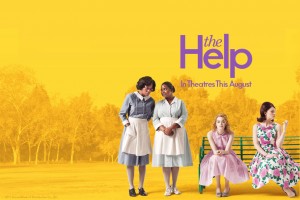
We so often assume that the best way to combat bigotry and ignorance is through awareness, that injustices of the past can be alleviated with the right knowledge and appreciation. Through history, we reason, the errors of the past are clear and guide us in improving the present and future. We delegate months to celebrate the specific histories of oppressed groups, produce films about their movements, and immortalize their leaders. In terms of social justice and oppression, the right move is always to talk about it, to remember. This makes perfect sense before considering the way we look at race today; we naturally can’t help but overlook the basic and purposeful ideological motives that lie behind contemporary forms of normalized racism. Though it is hard to stomach, widespread racist assumptions exist today just as the belief of the inferiority of black people existed in the 1930s. Denying this all together is naive and idealistic, on par with the suggestion that we live in a post-racial world. I am not arguing in any way that we should stop remembering and learning about civil rights movements, just that the way we present them (and everything, for that matter) is subject to our fundamental ideologies. Oftentimes these ideologies are so elusive to identification that they are often perceived as instances of racial harmony, friendship, and progress.
This is a difficult distinction to make, but after having done so, I am reminded of an unintentionally hilarious interview of Morgan Freeman, in which he proclaims that the best way to end racism is to simply “stop talking about it.” As seemingly nonsensical as this first seems, it also makes a lot of sense– oftentimes when we attempt to discuss or portray racial struggles, ideological biases cloud our reasoning. They can incline us to be overly optimistic and make false assumptions the same way that pictures of black and white children holding hands on Facebook can convince your aunt that we live in a racially harmonious and equal society.
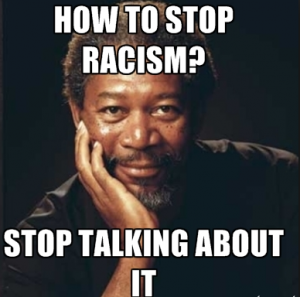
Meme of Freeman’s famous quote from described interview
A well-documented formula for the depiction of race in film is seen in the trope of the “white savior” that cuts across almost every genre and era of entertainment. In more modern examples, films with this archetypal structure frequently masquerade as stories of redemption and justice in which a white character rescues a poor non-white character from their suffering. Presented without any form of autonomy, minorities in white savior films are presented as helpless and primitive, in need of the redemption that a white savior brings to improve their menial lives. Movies like The Blind Side and The Freedom Writers portray this motif all too clearly– depicting white women who use their resources and intellect to “get through” to black and latino/a youth, forever transforming their lives and creating an awareness in them that they can forge a path out of the struggle they were so unfortunately born into.
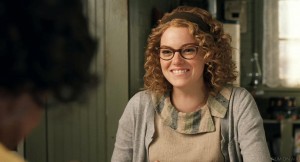
Eugenia “Skeeter” Phelan: The Savior
Even in our depiction of slavery and segregation this trope resurfaces its ugly head, often misinterpreting and devaluing key aspects of the civil rights movement. And rarely is it ever so compelling as it is in The Help, a film directed by Tate Taylor based on the novel by Kathryn Stockett that follows the ambition of Eugenia “Skeeter” Phelan as she writes a novel from the perspective of black maids who raise the children of prominent white families during the early 1960s. Skeeter (as a typical white savior) is the catalyzing force of change in the film, as her bravery and acceptance of the black maids is depicted as the only reason anything significant even happens in the previously-stagnant town of Jackson, Mississippi. Rather than the culmination of decades and decades of racism inspiring black leaders to unite the black community and inspire change, the fact that it is impressed by an oddball, white, feminist figure primarily driven by the emotional attachment she had for her childhood maid not only devalues the history of the civil rights movement, but also proposes an uncomfortable proposition that black people wouldn’t have been able to strive for justice if it wasn’t for compassionate white people.
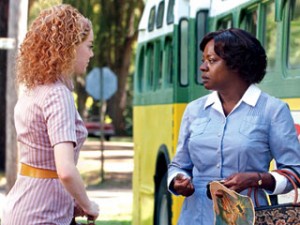
Skeeter approaches Aibileen at a black bus stop
Not only is Skeeter the typical white savior, she is also inexplicably clueless regarding the accepted social norms that govern interactions between black and white people in Jackson. The first maid Skeeter reaches out to is Aibileen, with the purpose of getting her help to write a cleaning advice column. Skeeter later tells Aibileen about her idea for the novel excitedly, obviously without having considered how dangerous such a pursuit could be for a black woman. Skeeter then approaches Aibileen again for an answer at a black bus stop, completely oblivious to how strange it looks for her to be there, a detail that is conveyed cinematically through the obvious confusion of the white people observing the interaction in the background. Skeeter assures Aibileen that they will be safe, to which a disgruntled Aibileen notes responds “this already ain’t safe” and that the way Skeeter is going about creating this novel “scares [her] more than Jim Crow.” Only is it after Aibileen agrees to participate and the two meet up that Skeeter says she “know[s] now that what [they’re] doing is illegal.” The extent of Skeeter’s cluelessness regarding commonplace racial interactions and taboos in her hometown has no real explanation. Sure, she went away to Ole Miss for college for four years, but after having spent at least seventeen years in Jackson before leaving, it’s fair to say that she should have at least a rudimentary understanding of the power balances between black and white people in her home town (especially when it comes to potentially endangering her primary ally Aibileen). Her apparent “color-blindness” and empathy for black women make her an anachronistically perfect savior in a society that would be more realistically portrayed as overwhelmingly and monotonously racist.
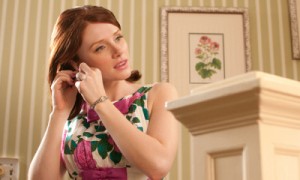
Mrs. Hilly Holbrook: The Villain
Hilly, the villainous racist of the novel, is the exact opposite of Skeeter. Basically a racist mean girl-esque socialite bully, Hilly pushes for legislation requiring the help have separate bathrooms in every home, and tries to frame Aibileen for stealing silverware to have her arrested. Where Skeeter is unaware of certain social conventions, Hilly epitomizes them. She is the president of the Junior League, and maintains power over the other white women of Jackson thorough blackmail and threats. She sticks staunchly to her pro-segregation beliefs, readily punishing those who disagree, and even fires her maid Minny Jackson for using her toilet. Despite this, through much of the film she is shown to be preoccupied with her charity efforts for the “Poor Starving Children of Africa Fund.” In this way The Help almost seems to be mocking the white savior complex– depicting the faulty logic behind the Junior League of Women who would never offer to help the children of their maids, but work instead to send food to the starving children in Africa. This detail functions as a not-so-subtle jab at Hilly, who in a previous scene refused to give her maid Yule May Davis a fifty dollar advance to allow her to send both of her sons to school, leaving her with the choice of deciding which one to send.
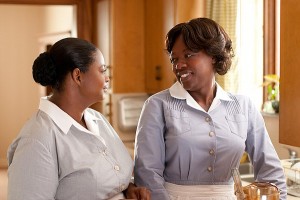
Minny Jackson (Left) and Aibileen Clark (right)
Trapped between these hero and villain figures are the maids. Particularly Minny Jackson and Aibileen Clark, the latter being the most central maid in novel (also the narrator of the film), as the first to talk to Skeeter and as a connection to the rest of the black community. One of the most important things Aibileen does is reach out to other maids to tell their stories, explaining that she and Skeeter “ain’t doing no civil rights” but rather “telling stories like they really happen.” This is the most recognizable point in the movie that depicts Aibileen’s initial submissiveness to the racism that permeates her life. The apparent dissatisfaction in Aibileen is connected to her son’s death in a senseless accident that plants a “bitter seed” in her that severely lessens her patience with her boss, Mrs. Leefolt. Despite this, she maintains a torturous yet quiet obedience, never does it seem that she is criticising or objecting to the racism of the south so much as enduring it expectantly. In a dramatic scene at the end of the movie, Aibileen strides into the sunlight after being fired by Mrs. Leefolt, recounting how being able to tell the truth to Skeeter was “liberating” to her as she decides to leave her life as a maid behind her and pursue a life dedicated to writing the stories of those around her– just as Skeeter had done for her. Aibileen’s transition from the stereotypical obedient, matronly, and religious maid to an activist dedicated to those around her happens quite suddenly in the film and is very clearly only a result of the actions of Skeeter.
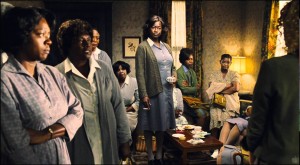
Maids inspired by Aibileen to speak to Skeeter
So why is it important that Skeeter is white, and so unaware of the social conventions of Jackson, and that Hilly is the epitome of these conventions at play? Where does Aibileen come in in the mix? The answer to the first of these questions is that having a completely pure, positive white character is a surefire way to absolve the sensitivities of white audiences dealing with the inherent conflict they have viewing and living in such a racial world. Many white moviegoers constantly feel victimized by racially-based conflicts in film. Thus, saviors like Skeeter play an integral role in alleviating their tiredness with the topic, by depicting a white person going the extra mile for people of color who can’t. In doing this, the film essentially provides white people a reason to feel better when looking back to times such as the civil rights movement. Skeeter’s presence in the plot line of The Help is what makes it, for many, an uplifting movie about racial cooperation rather than a black movie about civil rights. Thus the fictional trope of the white savior functions to solve a very real problem– the modern “tiredness” and guilt white people have living in a racial world so clearly attributed to the actions of white people that must be completely absolved for a movie such as The Help to be successful.
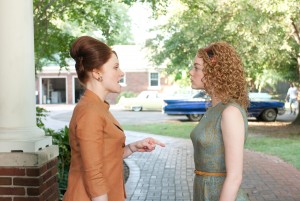
Mrs. Hilly vs. Skeeter
So what exactly is the cost of placating white audiences whenever race is a topic of interest in film? In essence, the feelings of white viewers are placed over those of minorities by compromising the representation of minorities in film. The instances of cooperation and friendship between Skeeter and the maids subverts the concept of white supremacy at a higher level, confronting segregationist, KKK-level racism, but it also exists more subliminally, weakening the characterization of black figures, oftentimes conveying less obvious messages of white supremacy through the stereotypes of black dependency and white paternalism. In the film, characterization of Skeeter and Hilly as opposites brings us to a generic conversation of good versus evil, a much too simple juxtaposition when considering the complexities of race in the 1960s or today. Hilly’s complete entrenchment in the social norms of society versus Skeeter’s complete rejection of these norms is a dichotomy that is depicts a lot about the function of how we view race ideologically. It concludes that racism exists in the binary: white or black, racist or not. It further attributes racism as a whole to the anger and brokenness of a few “bad eggs,” rather than any sort of organized and systematic oppression. Skeeter is not racist because she is an educated, wholesome person. Hilly is because she is vindictive, mean, and manipulative. The time period and culture they were both born into is given no weight at all. Minorities, in the meantime, are secondary to this conflict of good versus evil. Hilly and Skeeter make all of the moves, battling out the fate of the help who do little more than observe and obey them. The biggest step the black women make is in the decision to talk to Skeeter, which as evident through my discussion of this earlier, is ultimately nothing more than a show of black dependence.
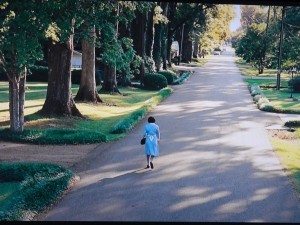
End scene: Aibileen walks into the sun, contemplating her new path as a writer
The trivialization of black characters in order to minimize white guilt through the usage of a white savior is not only indicative of normalized racial ideologies that each of us is likely to be carrying around with us, it also goes to show how Morgan Freeman could be correct in some regard about talking about racism. Though I disagree and still see value in realistic discussions regarding race, it is interesting to question how the discussed ideological motives will continue to permeate in our thoughts. In other words, what if the same desire to create awareness that led to films like The Help and other white savior movies is still leading us further from the actual significance of history and deeper into a new undecipherable ideological mess? At that point I’d definitely be ready to stop talking about it. But hell if I know.
________________________________________________________________________________________
Hughey, Matthew W. “White Savior Films: The Content of Their Character.” The White Savior Film: Content, Critics, and Consumption. N.p.: n.p., n.d. N. pag. Print.
Weiss, Joanna. “‘The Help’: America Pats Itself on the Back.” Boston.com. The New York Times, 16 Aug. 2011. Web. 17 Oct. 2016. <http://archive.boston.com/bostonglobe/editorial_opinion/oped/articles/2011/08/16/the_help_america_pats_itself_on_the_back/>.